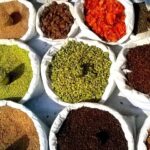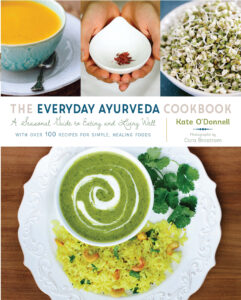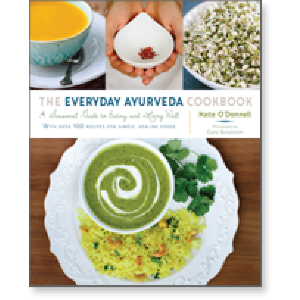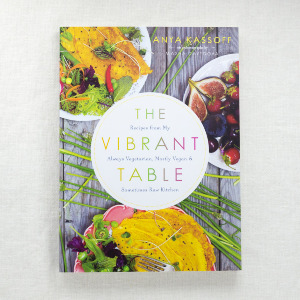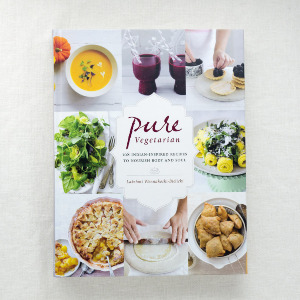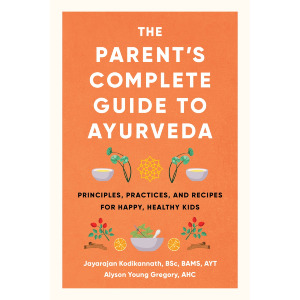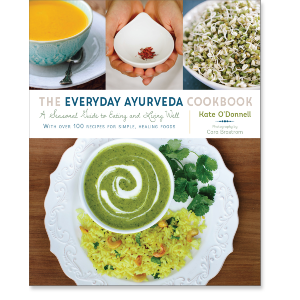The first days of autumn have come. With the help of Ayurvedic practice and recipes from Kate O‘Donnell‘s Everyday Ayurveda Cookbook, we explore valuable adjustments to our everyday routines that can help maintain balance through this transitional time.
As the mornings grow cooler and the heaviness of summer air begins to dissipate, it becomes time to lean into the change of seasons through adjustments to one’s lifestyle and diet. The beginning of the fall season is an ideal time to prepare ourselves for the winter months ahead by “clearing out accumulated summer heat and storing nourishment in the deep tissue layers to sustain energy through the winter.” These rituals can aid the physical and mental stress many of us experience as the days grow shorter.
Ayurvedic practice approaches the year as three seasons that correspond with the three doshas which translates literally to “that which is at fault.” There is vata season, which begins in autumn and goes until winter has settled in; kapha season which holds the coldest months of winter and the early months of spring; and pitta season which embraces the longest, hottest days of the year. Ayurvedic practice keeps the qualities of each season in check by advising that we use opposites in our routines. For example, during the summer, or pitta season, many of us take cool showers and eat cooling foods to keep from feeling overheated.
To maintain balance in the body, it is important that we are conscientious of the qualities of each season so that we can avoid both lack and excess. In this way, we can gracefully move through this transitional time from summer into fall, a movement from pitta (July–October) into vata (November–February). Because pitta describes qualities of warmth, we can think of it in traits similar to those that we assign to the summer heat, such as sharp, oily, and permeating. Vata, alternately, can be described as light, dry, and cool. During pitta season, we counter warm, oily qualities with cool, calm, dry ones, but as the weather begins to turn vata it is important that we introduce more oily and dense foods, as well as warming practices, to avoid an excess of dryness or chill.
The Everyday Ayurveda Cookbook recommends that during the fall season we:
- “Use a warm, medium-bodied oil, such as almond or sunflower, for morning massage.” Additionally, adding “woody, grounding” essential oils, such as sage or cedar, can be therapeutic.
- “Consume warm food and drinks [including water]. Avoid skipping meals, and do not fast.”
- Favor root vegetables and cooked cold-weather greens.
- Seek out sweet, heavy fruits in the early fall, including bananas, mangoes, apples, pears, and cranberries.
This major shift in seasonal qualities often encourages us to adjust our routines subconsciously. As the weather begins to change, we naturally gravitate toward habits and food choices that help us to feel in sync with the season, but it is important to be mindful of symptoms of imbalance.
Imbalance in autumn can present itself as:
- “Dry skin and scalp.”
- Anxious feelings.
- Upset stomach or signs of indigestion.
- Illness (cold and flu).
Ayurvedic practice grants us the ability to incorporate natural rhythm into our daily lives. Embracing the change of seasons can be a wonderful way to tune into our bodies’ wants and needs, practice nourishment as a means of self-care, and bring mindful practice into our daily routines.
Related Books
The Everyday Ayurveda Cookbook
$29.95 - Paperback
$24.95 - Paperback
At Home in the Whole Food Kitchen
$40.00 - Hardcover
$20.95 - Hardcover
Red Pumpkin Dal
4 cups water or 3 cups water plus one 16-oz can coconut milk
1 cup red lentils
1 tsp Fall Spice Mix
1 tsp dehydrated sugarcane or maple syrup (optional)
1 small kabocha squash (about 2 cups, chopped)
½ tsp salt
Tempering
1 tsp coconut oil
1 tsp grated fresh ginger
½ tsp cumin seeds
½ tsp mustard seeds
2 tbsp shredded coconut
Boil the water and coconut milk, if using, in a large saucepan on high heat. Rinse the red lentils until the water runs clear. Add lentils to the boiling water along with the spice mix and sweetener. Allow to come to a boil again, uncovered. Then turn heat down to medium.
Chop the squash, peel and all, into 1-inch cubes. Add to the saucepan. When it boils again, turn heat down to low and simmer, partially covered, for 30 minutes. Do not stir.
Heat the oil in a small frying pan on medium heat and temper the ginger, cumin seeds, and mustard seeds until you smell them, just 2–3 minutes. Take the pan off the heat and stir the shredded coconut into the hot pan. Continue to stir for a minute or two as the coconut browns.
Add this tempering to the lentils and squash, along with the salt. Simmer the dal, uncovered, for 5 minutes more.
Serve as a soup or ladle over rice.
NOTE: Kabocha skin, unlike butternut or acorn squash, gets completely soft and adds a green color to the dish. I would much rather eat it than peel it, but it works both ways if you would like to cut the peel off before cubing. (p. 206)
For more information on Ayurvedic history and practice, see The Everyday Ayurveda Cookbook.

